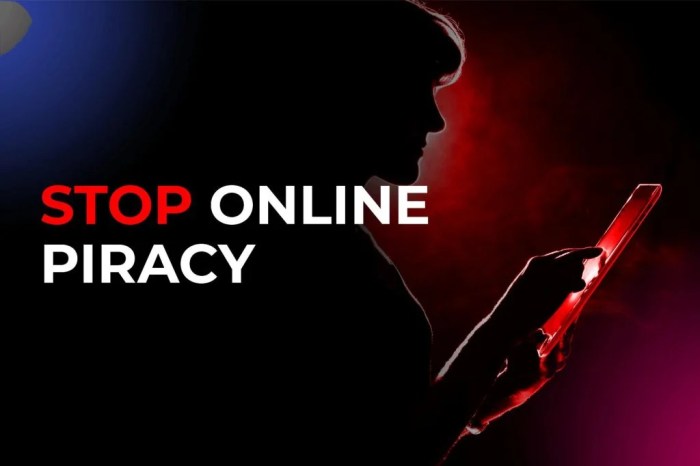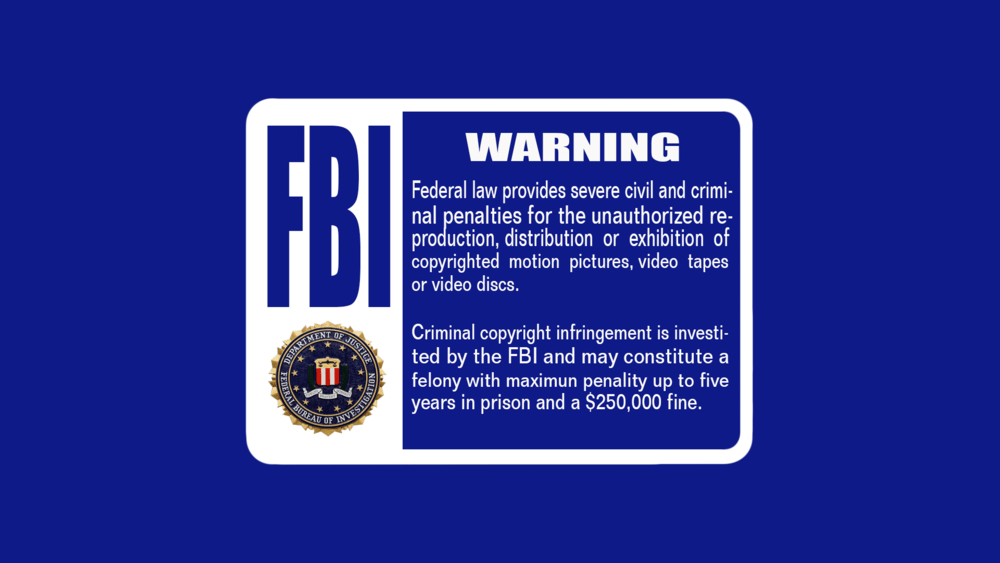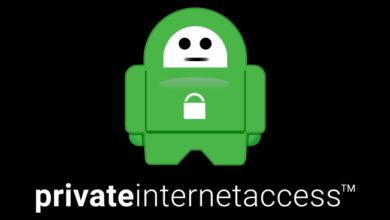Anti-Piracy Begins at Home Protecting IP
Anti piracy begins at home – Anti-piracy begins at home. This isn’t just about downloading movies or music without paying; it’s a crucial aspect of respecting intellectual property rights across various industries, from software to music and beyond. Understanding the different forms of piracy, from simple file-sharing to sophisticated online networks, is vital. This exploration delves into the personal responsibility we all have in combating piracy, examining the impact of our choices and actions on a broader societal level.
Protecting intellectual property rights is not just about adhering to laws; it’s about fostering a culture of respect and understanding. It involves recognizing the value of creativity and the effort that goes into developing software, music, and films. Our actions at home, from choosing to purchase legitimate products to educating our families about the implications of piracy, can have a powerful ripple effect on the broader anti-piracy movement.
Defining “Anti-Piracy”
Protecting intellectual property is crucial for creators and industries. This involves a multifaceted approach to combatting piracy, a complex issue with far-reaching consequences. Understanding the various forms of piracy, the legal and ethical implications, and the potential repercussions for those involved is key to developing effective anti-piracy strategies.Anti-piracy efforts must go beyond simply identifying and punishing illegal activity.
It’s about proactively educating consumers about the importance of respecting intellectual property rights and providing alternatives to illegal downloads. This also involves fostering a culture of ethical consumption within the industries themselves.
Forms of Piracy
Piracy encompasses a wide range of illegal activities targeting diverse industries. It’s not just limited to downloading movies or music; it includes counterfeiting physical goods and software theft. This section will clarify different types of piracy impacting various sectors.
- Software Piracy: This involves copying, distributing, or using software without authorization. It can affect companies like Microsoft, Adobe, and Autodesk, resulting in significant financial losses. Unauthorized copies can contain malicious code, compromising user data and security.
- Music Piracy: Illegally downloading, sharing, or distributing copyrighted music is a prevalent form of piracy. This hurts musicians, labels, and music streaming services by reducing revenue streams and impacting their ability to create new music.
- Movie Piracy: Unauthorized distribution of copyrighted films, often through online platforms, deprives filmmakers, studios, and actors of legitimate revenue. It affects the ability to create new productions and maintain existing industry infrastructure.
- Intellectual Property Piracy: This encompasses the unauthorized copying or use of trademarks, patents, and other forms of intellectual property. This impacts businesses across various sectors, including fashion, pharmaceuticals, and technology.
Anti-Piracy Strategies
Anti-piracy strategies are diverse, incorporating legal, technological, and educational measures. These approaches aim to deter and combat illegal activity while supporting ethical practices.
- Legal Measures: Laws and regulations play a critical role in deterring piracy. Copyright laws, criminal penalties for infringement, and civil lawsuits are examples of legal strategies employed to combat piracy. Governments can cooperate internationally to address transnational piracy.
- Technological Measures: Companies often utilize digital rights management (DRM) technologies, watermarking, and encryption to protect their content. These technologies aim to prevent unauthorized copying and distribution. Advanced detection systems identify and block illegal downloads or streaming.
- Educational Measures: Raising public awareness about the importance of respecting intellectual property rights is a crucial part of anti-piracy efforts. Educational campaigns can highlight the economic and creative damage caused by piracy. Transparency regarding the cost of piracy to individuals and businesses can be an important aspect.
Legal and Ethical Implications
Piracy has significant legal and ethical implications. From a legal perspective, it often involves violating copyright laws and intellectual property rights, leading to potential legal action and penalties.
- Legal Consequences: Individuals involved in piracy can face civil and criminal penalties, including fines, imprisonment, and injunctions preventing further infringement. The severity of the penalties varies based on the type and extent of the piracy.
- Ethical Considerations: Piracy undermines the creative process and the economic viability of the industries involved. It also potentially deprives artists and creators of their rightful compensation for their work. This can be seen as unethical and morally questionable.
Consequences for Individuals and Organizations
The consequences of piracy can be significant for individuals and organizations involved in the illegal activity. These consequences can range from financial penalties to criminal charges.
- Individual Consequences: Individuals involved in piracy can face financial penalties and legal repercussions. This can range from substantial fines to imprisonment, depending on the severity of the offense. Their reputation and future prospects may also be negatively affected.
- Organizational Consequences: Organizations involved in piracy can suffer significant financial losses, including lost revenue and damaged brand reputation. These losses can severely impact the organization’s ability to function and compete in the market.
Piracy vs. Legal Repercussions
| Type of Piracy | Legal Repercussions |
|---|---|
| Software Piracy | Fines, lawsuits, criminal charges, and injunctions. |
| Music Piracy | Copyright infringement, potential fines, and legal action. |
| Movie Piracy | Copyright infringement, substantial fines, and legal action. |
| Intellectual Property Piracy | Trademark infringement, patent violation, and civil/criminal penalties. |
The Concept of “Begins at Home”
The phrase “anti-piracy begins at home” isn’t just a catchy slogan; it encapsulates a crucial societal shift in how we combat intellectual property theft. It emphasizes the individual’s role in upholding ethical consumption and production practices, recognizing that widespread piracy is often a reflection of individual choices. It underscores the interconnectedness of personal responsibility and the broader societal impact of our actions.The “anti-piracy begins at home” concept highlights the idea that combating piracy isn’t solely the responsibility of corporations or governments.
It’s a collective effort where each individual plays a critical part in creating a culture that respects intellectual property rights. This approach shifts the focus from punitive measures to proactive education and awareness. By fostering a sense of personal responsibility, we can create a sustainable environment where piracy is less prevalent and the rights of creators are better protected.
Personal Responsibility in Combating Piracy
Personal responsibility is fundamental to effectively combating piracy. Individuals must actively make conscious choices about how they access and consume content. This means opting for legitimate sources and respecting the rights of creators. When individuals choose to download or share pirated content, they inadvertently contribute to a system that harms creators and the creative industries. A culture of personal responsibility fosters a deeper understanding of the economic and social repercussions of piracy.
Impact of Personal Choices on Broader Anti-Piracy Efforts
Personal choices have a significant impact on broader anti-piracy efforts. When individuals consistently choose legal alternatives, they strengthen the market for legitimate products and services. This positive feedback loop supports creators and encourages further investment in creative endeavors. Conversely, widespread piracy diminishes the incentives for creating and innovating, potentially hindering the development of new ideas and technologies.
The ripple effect of individual choices creates a dynamic environment where ethical consumption plays a pivotal role in fostering a sustainable creative ecosystem.
Importance of Education and Awareness
Education and awareness play a critical role in fostering anti-piracy attitudes. Educating individuals about the consequences of piracy, both legally and economically, is essential. This understanding goes beyond just legal ramifications to encompass the impact on creators’ livelihoods and the broader creative industry. Understanding the economic impact of piracy on individuals, businesses, and communities further reinforces the importance of ethical choices.
Raising awareness through accessible information campaigns and educational programs can shape attitudes and behaviors toward intellectual property rights.
Demonstrating Anti-Piracy Behaviors at Home, Anti piracy begins at home
Cultivating anti-piracy behaviors at home is a vital step in fostering a culture of respect for intellectual property. These behaviors are not just about individual actions but also about setting an example for others within the household and community. A strong foundation of ethical consumption within the home environment creates a powerful ripple effect.
- Legitimate Content Acquisition: Prioritize purchasing licensed software, music, films, and other forms of creative content. Using legitimate platforms and services is a direct way to support creators and avoid contributing to piracy.
- Promoting Ethical Consumption: Discuss the importance of respecting intellectual property rights with family members. Encourage the use of legitimate alternatives and discourage the downloading or sharing of pirated content.
- Media Literacy: Educate family members on identifying and avoiding pirated content online. Developing media literacy skills helps individuals make informed choices and avoids unwittingly contributing to piracy.
- Support for Creators: Encourage the consumption of products and services that support creators directly. This includes attending live performances, buying merchandise, and supporting creators through platforms that prioritize their work.
- Open Communication: Create an environment where open discussions about intellectual property rights can take place. This fosters understanding and encourages ethical consumption practices within the household.
Anti-Piracy Measures at Home
Protecting intellectual property isn’t just about big corporations; it’s a shared responsibility. Piracy, whether it’s downloading copyrighted music or software, undermines creators and the entire creative ecosystem. Understanding how piracy manifests in domestic settings is crucial to establishing a proactive anti-piracy environment.Protecting the creative industries isn’t just about stopping piracy, but also about fostering a culture of respect for intellectual property rights.
Common Methods of Home Piracy
Home piracy often involves methods that bypass traditional licensing and distribution channels. Downloading copyrighted material without authorization is a widespread practice. This can include illegally downloading movies, music, software, and even e-books. Peer-to-peer (P2P) file-sharing networks are frequently used to facilitate these activities, enabling users to share and download copyrighted content directly from other users. In some cases, physical media, such as DVDs or CDs, may be illegally copied and distributed.
Examples of Software, Music, and Movie Piracy in Domestic Settings
A common example of software piracy is installing unlicensed copies of operating systems, productivity suites, or game software. Music piracy manifests in downloading songs from unauthorized sources, often through file-sharing services or websites. Movie piracy can involve downloading or sharing pirated copies of films through various online platforms. These actions not only harm the creators but also contribute to the spread of illicit activities.
Practical Steps to Prevent Piracy at Home
Establishing a culture of respect for intellectual property rights is vital. Purchasing legitimate copies of software, music, and movies is a fundamental step. Legitimate sources provide better quality and support. Utilize authorized digital distribution platforms for accessing entertainment content. Employing strong password protection and firewall measures on home networks can also deter unauthorized access to copyrighted material.
Educating family members about the legal and ethical implications of piracy is essential to prevent unintended participation in such activities.
Anti-Piracy Measures Effectiveness Comparison
| Measure | Effectiveness ||——————————————-|———————————————————————————————————————————————————————————————————-|| Purchasing legitimate copies | High.
Direct support for creators, and legal access. || Utilizing authorized digital platforms | High.
Provides legal access and often better quality than pirated versions. || Strong passwords and firewalls | Moderate.
Deters unauthorized access, but not foolproof against determined individuals. || Education and awareness | High.
Creating a culture of respect for intellectual property rights significantly reduces the likelihood of participation in piracy. || Monitoring and restricting internet access | Moderate.
Effective for children or individuals who may be unaware of the risks, but difficult to fully control and can lead to conflict. |
A Step-by-Step Guide to Establishing an Anti-Piracy Environment
1. Educate Family Members
Discuss the ethical and legal implications of piracy. Explain the impact on creators and the importance of respecting intellectual property rights.
Protecting intellectual property starts with us, at home. We need to be mindful of our consumption habits, and understand the broader political landscape surrounding technology, like RFID. This directly impacts the tech marketplace, as seen in rfid politics and the technology marketplace. Ultimately, understanding these issues, from the home to the marketplace, reinforces the importance of anti-piracy initiatives, ensuring a fair and sustainable tech environment for everyone.
2. Establish Clear Rules
Create and enforce guidelines regarding the downloading and sharing of copyrighted material. Specify the acceptable use of the internet.
3. Promote Legal Alternatives
Encourage the use of authorized digital distribution platforms for accessing music, movies, and software. Provide options for purchasing and streaming.
4. Implement Strong Security Measures
Employ strong passwords and firewalls to protect the home network. Monitor internet activity, especially for children.
5. Regularly Review and Update
Fighting piracy starts at home, fostering a culture of respecting intellectual property. Companies like Yahoo and EarthLink are crucial in this fight, building robust defenses against online fraud like spoofing, as demonstrated by their recent measures against phishing attempts. This initiative, detailed in yahoo earthlink build bulwark against spoofing , highlights the importance of proactive security measures.
Ultimately, though, the responsibility for upholding ethical digital practices falls on each of us.
Periodically review the established guidelines and security measures. Keep up-to-date with evolving piracy methods and adjust strategies as needed.
Educational Initiatives and Awareness
Educating individuals about the importance of ethical digital practices and the detrimental effects of piracy is crucial in combating the issue. This approach emphasizes proactive measures rather than solely focusing on punishment. By instilling a sense of responsibility and understanding, we can cultivate a culture that values intellectual property rights. A strong educational foundation empowers individuals to make informed choices and discourages participation in illegal activities.Educational programs play a pivotal role in shaping attitudes towards copyright infringement.
These programs can introduce individuals to the concept of intellectual property, the consequences of piracy, and the benefits of legal access to content. By emphasizing the economic and creative impact of piracy, these initiatives help people understand the broader implications of their actions. This understanding can lead to a shift in behavior and a greater appreciation for the value of original work.
Educational Materials Promoting Ethical Digital Practices
A variety of educational materials can effectively promote ethical digital practices. These resources can take many forms, including interactive workshops, informative presentations, and engaging online modules. For example, schools can incorporate case studies of individuals who have faced legal repercussions for piracy, showcasing the real-world consequences. Educational materials can also explore the economic impact of piracy on creators, studios, and artists, highlighting the financial losses and the impact on job opportunities.
Illustrative examples of successful campaigns, including the ones implemented by organizations like the MPAA, often demonstrate the positive results of proactive awareness campaigns.
Integrating Anti-Piracy Messages into Everyday Curriculum
Integrating anti-piracy messages into the curriculum across different subjects is a valuable approach. For instance, lessons on copyright law in civics classes can explain the legal framework surrounding intellectual property. In technology classes, students can learn about the technical aspects of piracy and the tools used to combat it. Furthermore, ethical considerations related to digital content can be discussed in literature and art classes.
By weaving these concepts into existing subjects, anti-piracy messages become an integral part of a student’s learning experience, rather than a separate, isolated topic.
Online Resources and Tools for Educating Individuals
Numerous online resources and tools are available to educate individuals about anti-piracy. These include interactive websites, videos, and educational articles. Many organizations dedicated to copyright protection have developed websites with detailed information on copyright laws, the impact of piracy, and how to access content legally. For instance, the website of the Recording Industry Association of America (RIAA) provides detailed information on music piracy, along with educational materials and resources.
These resources provide accessible information for individuals to learn about the issue and take action.
Comparison of Educational Approaches to Anti-Piracy
| Approach | Description | Strengths | Weaknesses |
|---|---|---|---|
| Interactive Workshops | Hands-on sessions with interactive elements | Engaging, promotes active learning, immediate feedback | Requires trained facilitators, potentially limited reach |
| Online Modules | Self-paced learning through digital platforms | Accessible to a wider audience, flexible scheduling | May lack personal interaction, requires self-discipline |
| Case Studies | Analysis of real-world scenarios of piracy | Demonstrates real-world consequences, builds credibility | Potentially sensitive content, requires careful selection |
| Curriculum Integration | Incorporating anti-piracy messages into existing subjects | Subtle and integrated learning, reinforces understanding | Requires teacher training, potentially limited time allocation |
Individual and Organizational Impact
Fighting piracy isn’t just about protecting intellectual property; it’s a collective effort that impacts individuals and organizations in profound ways. Individual actions, when multiplied, create a powerful societal force against illicit activities. Organizations, too, benefit from a strong anti-piracy culture, fostering trust, preserving profitability, and maintaining a positive brand image. This section will delve into how individual actions contribute to the larger effort, the advantages of a robust anti-piracy ethos for organizations, and the vital role of legal frameworks and compliance in preventing piracy.
Individual Anti-Piracy Actions
Individual actions, seemingly small, contribute significantly to a robust anti-piracy culture. When individuals refuse to participate in piracy, they reinforce a societal norm against such practices. This collective resistance discourages further illicit activities, setting a precedent for ethical behavior. This includes purchasing legitimate products, reporting suspected piracy instances, and educating others about the detrimental effects of piracy.
By understanding the ripple effect of their actions, individuals can contribute to a stronger, more ethical society.
Organizational Benefits of Anti-Piracy Culture
A strong anti-piracy culture within an organization yields numerous benefits. It fosters trust among employees, customers, and stakeholders. By demonstrably valuing intellectual property, organizations establish credibility and maintain a positive brand image. This, in turn, attracts and retains customers, as well as potentially securing more investment opportunities. Further, a proactive anti-piracy approach often prevents significant financial losses associated with lost revenue and legal fees.
Implementing Anti-Piracy Policies and Practices
Organizations can implement several strategies to embed anti-piracy policies within their structures. First, establish clear and concise policies regarding intellectual property. This includes outlining acceptable use of copyrighted materials and the consequences for violations. Furthermore, implement robust monitoring systems, such as watermarking or digital rights management (DRM) technologies, to track and prevent unauthorized copying. Regular training and awareness programs are also crucial for reinforcing the importance of anti-piracy policies among employees.
Importance of Legal Frameworks and Compliance
Legal frameworks are essential to support anti-piracy efforts. These frameworks provide the legal tools and penalties necessary to deter piracy. Understanding and complying with copyright laws, licensing agreements, and other relevant regulations is crucial. This includes having a clear understanding of how intellectual property is protected in different jurisdictions and ensuring that all company activities adhere to these regulations.
Failure to comply can lead to significant legal repercussions and financial losses.
Protecting intellectual property, like fighting piracy, starts with us. It’s a global issue, but the groundwork for fair play often begins at home. This is especially relevant now, as EU antitrust regulators are closely examining the Oracle deal, highlighting the importance of fair competition and avoiding monopolies in tech. Ultimately, when we all respect copyright and intellectual property rights, the entire ecosystem benefits, just like respecting the rules of the digital marketplace.
This includes supporting fair competition, as exemplified by the EU’s scrutiny of the Oracle deal. Anti-piracy starts at home, with responsible digital citizenship. eu antitrust regulators scrutinize oracle deal
Comparing Organizational Anti-Piracy Strategies
Various anti-piracy strategies can be employed by organizations. Some strategies focus on technological solutions, such as DRM or watermarking. Others emphasize educational initiatives and awareness campaigns. Finally, some organizations adopt a multi-pronged approach combining technology, education, and legal frameworks. The effectiveness of each strategy varies depending on the specific context and the nature of the intellectual property involved.
A successful strategy typically involves a combination of proactive measures and responsive actions to address specific instances of piracy.
Technological Solutions and Countermeasures

Technological advancements have significantly impacted the fight against piracy. These solutions, while not a complete deterrent, offer powerful tools for protecting intellectual property and deterring illegal activities. They range from sophisticated watermarking techniques to advanced encryption methods, all designed to make it harder for pirates to copy and distribute copyrighted material. By understanding these technological approaches, we can better comprehend the evolving nature of the piracy landscape and the role technology plays in safeguarding creativity.
Various Technological Solutions
Technological solutions for combating piracy are diverse and often interlinked. They employ a variety of approaches, from making copies harder to create to making it more difficult to distribute them. These techniques leverage digital signatures, encryption, and other methods to identify and trace unauthorized copies.
Digital Watermarking
Digital watermarking is a technique that embeds imperceptible marks into digital content, like images, videos, or audio files. These marks act as invisible signatures, linking the content to its rightful owner. Sophisticated watermarking algorithms can resist attempts to remove them, making it difficult for pirates to reproduce copyrighted material without leaving a trace. While effective, watermarking alone might not prevent piracy, but it strengthens the case against it in legal proceedings.
Encryption and Access Control
Robust encryption plays a crucial role in safeguarding intellectual property. Encrypted content can only be accessed by authorized users with the correct decryption keys. This significantly reduces the appeal of illegal copies as the difficulty and cost of acquiring a key are substantial. Streaming services and software often employ advanced encryption to protect their content from unauthorized access and copying.
Content Identification and Tracking
Content identification and tracking systems use algorithms to recognize specific characteristics of copyrighted material. These systems can detect and track unauthorized copies across various platforms, helping to trace the source of illegal distribution. This technology aids law enforcement in pursuing those responsible for distributing pirated content.
Anti-Piracy Software and Tools
Specialized software and tools are available to help monitor and detect piracy attempts. These tools often utilize advanced algorithms to identify patterns in file sharing and download activities. Examples include monitoring systems for file-sharing networks and content delivery networks (CDNs). They provide valuable insights into piracy patterns and help identify potential hotspots for illegal activity.
Table: Anti-Piracy Technologies and Applications
| Technology | Application | Strengths | Weaknesses |
|---|---|---|---|
| Digital Watermarking | Images, videos, audio | Adds an invisible signature, difficult to remove | May not prevent all piracy, can be circumvented |
| Encryption | Streaming services, software | Protects content from unauthorized access | Requires strong keys and robust systems |
| Content Identification | Detecting unauthorized copies | Tracks and identifies illegal copies | Requires ongoing updates and vigilance |
| Anti-Piracy Software | Monitoring file-sharing networks | Identifies patterns in illegal activity | Can be costly to implement and maintain |
The Role of Government and Law Enforcement

Governments play a crucial role in combating piracy, acting as the ultimate enforcers of intellectual property rights. Their actions often involve legislation, law enforcement, and collaboration with industry stakeholders. Without robust governmental support, effective anti-piracy measures are significantly hampered.Governments have a responsibility to create a legal framework that clearly defines intellectual property rights and Artikels penalties for infringement.
This framework ensures that individuals and organizations understand the consequences of piracy and discourages such activities. The strength and clarity of these laws are essential for successful anti-piracy campaigns.
Government Initiatives to Combat Piracy
Governments often implement a range of initiatives to address piracy, including public awareness campaigns, targeted investigations, and the prosecution of offenders. These initiatives vary based on the specific context and the prevalence of piracy within a given jurisdiction. They aim to deter future infringements and hold violators accountable.
- Public awareness campaigns often target consumers and educate them about the negative impact of piracy. These campaigns highlight the economic and ethical consequences of supporting illegal activities, promoting responsible consumption and the value of original works. Examples include educational materials distributed in schools, online advertising, and public service announcements.
- Targeted investigations and prosecutions are key components of government anti-piracy efforts. These initiatives involve law enforcement agencies identifying and investigating individuals or organizations involved in piracy. The process often includes gathering evidence, obtaining search warrants, and bringing offenders to justice. The success of these investigations often hinges on effective cooperation with industry stakeholders who can provide crucial insights and evidence.
- International cooperation is essential for combating piracy that transcends national borders. Agreements and treaties between countries allow for the exchange of information and the coordination of investigations. This collaboration facilitates the prosecution of individuals and organizations engaged in cross-border piracy, addressing the complex nature of global piracy networks.
Collaboration Between Law Enforcement and Industry
Effective anti-piracy efforts necessitate strong collaboration between law enforcement agencies and industry representatives. This collaboration allows for the sharing of information, the development of effective strategies, and the coordinated pursuit of violators. The exchange of intelligence and expertise is critical for identifying and disrupting piracy networks.
- Information sharing is crucial for law enforcement to effectively combat piracy. Industry partners can provide valuable intelligence about piracy activities, including online marketplaces, distribution networks, and individual offenders. This information allows law enforcement to prioritize their efforts and allocate resources effectively. Examples of this include identifying illegal online marketplaces or tracing the origins of pirated goods.
- Joint investigations often involve law enforcement agencies working alongside industry representatives. This collaboration allows for a deeper understanding of the intricate workings of piracy networks, enabling law enforcement to identify key players and dismantle operations more effectively. This collaboration is vital for successful prosecution of offenders and prevention of future infringement.
- Joint task forces are frequently established to address piracy. These task forces bring together representatives from law enforcement agencies and industry to develop and implement coordinated strategies. This approach provides a structured platform for collaboration, enabling efficient information sharing, joint investigations, and the development of proactive measures to prevent piracy.
Key Laws and Regulations
Intellectual property laws, such as copyright and trademark laws, are crucial for protecting original works and preventing piracy. These laws vary across jurisdictions, but their fundamental purpose is to grant creators exclusive rights to their creations. The strength and enforcement of these laws directly impact the success of anti-piracy efforts.
- Copyright laws grant authors exclusive rights to their original works, including books, music, films, and software. Infringing upon these rights can result in legal penalties. Countries often have specific legislation that Artikels the duration and scope of copyright protection.
- Trademark laws protect brand names and logos, preventing unauthorized use and imitation. The enforcement of trademark laws is critical to protecting brand reputation and preventing consumers from being misled by counterfeit goods. A clear understanding of trademark infringement is essential for individuals and organizations.
- International treaties and agreements play a vital role in standardizing intellectual property rights across borders. These agreements facilitate the enforcement of intellectual property rights globally, ensuring that creators and businesses can protect their works and brands internationally. The World Intellectual Property Organization (WIPO) plays a central role in promoting and facilitating these agreements.
Ultimate Conclusion: Anti Piracy Begins At Home
In conclusion, anti-piracy isn’t just a legal battle; it’s a cultural one. By understanding the various facets of piracy, from its forms and consequences to the role of personal responsibility, education, and technological solutions, we can collectively foster a society that values intellectual property. By taking proactive steps at home and embracing education, we empower ourselves and future generations to actively participate in the fight against piracy and contribute to a more ethical digital landscape.







